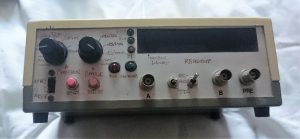Many years ago I used to repair TV’s and VCR’s plus any other bits of electronics I was given to repair. This was 20 to 30 years ago when consumer electronics were worth repairing and it was often worth it to purchase faulty goods from ex rental chains with the intention of repairing and resale. My main purpose of this was however to gain skills in electronics repair as at the time I was young and inexperienced. I was attending college but it helped to be able to practice at home.
One thing I found was the lack of test equipment made the job harder. All I had was a multimeter which made some faults especially signal tracing nearly impossible. This was years before cheap Chinese electronics and everything was made in the same country the manufacturer was based in. Ebay and the internet had yet to be invented and the only source of test equipment for the hobbyist were in surplus stores advertising in electronics magazines.
These also were too much for my budget. As luck would have it I purchased a second hand 1960’s oscilloscope for £20 if I remember correctly however the valves were all low emission and the adjustment controls were broken and / or noisy. As my dad worked at the skillcentre I managed to get it refurbished for free. It was a good scope until I inadvertently blew it up by connecting it to a live TV chassis. It got repaired but it was too big and heavy.
This got me thinking; what about making my own things? Well I still have some of the things I made but this was towards the end of my tinkering with electronics as work and other commitments took priority. Some of these projects were never finished and didn’t even get used. I seemingly went on a test equipment making frenzy making things to test components or used in a situation I’d hardly come across. The advancement of technology quickly made some things less useful such as logic probes. The advent of FPGA’s and custom IC’s quickly replaced 74 and 4000 series logic. Manufacturers also became reluctant to provide service information and increasingly things were being manufactured in the far east with next to no service information provided. Electronics were becoming a throw-away commodity.
Here’s a look at some of the most prominent things I have made. Others I have not mentioned as they have either been scrapped years ago or I feel are not worth putting on this page such as logic probes; they are simple gadgets after all.
Frequency counter project
This by far is the biggest waste of time and money as this thing isn’t even finished. It works to a fashion but there were fundamental problems in the design resulting in something that cost a lot of money in parts and didn’t work right. At the time I didn’t know how to put it right and I’d spent a lot of money on it.
As you can see from the photos it looks quite advanced. It is based on the ICL7216 frequency counter / timer IC and is built into a good quality ABS instrument case. The PCB on the left is the prescaler board I had 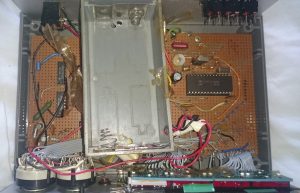 made to expand the range of the frequency counter but I never got round to connecting it up. The counter never got a use for it as I never had the need to measure any frequencies so it has been stuck in my cupboard for nearly 30 years with the intention of finishing it someday. You can see switches for selecting the range unconnected. What a waste of money.
made to expand the range of the frequency counter but I never got round to connecting it up. The counter never got a use for it as I never had the need to measure any frequencies so it has been stuck in my cupboard for nearly 30 years with the intention of finishing it someday. You can see switches for selecting the range unconnected. What a waste of money.
The main issue with this is the design; it is built on veroboard and with the high frequency RF signals bouncing around in this thing there is no shielding and there are signals crossing over to adjacent tracks resulting in readings being displayed when no signal was input. This thing would require a complete rebuild from scratch on a well designed etched PCB and the ancient ICL7216 IC is well obsolete; there are much better more modern alternatives that can do a better job. Hell there’s even one based on a Mega328 controller you can buy as a kit on ebay for next to nothing that is much better and more accurate than this. Just shows the advancement in technology.
It’s really just junk now but Ill keep it as that 8 digit LED display may come in handy for a future project. I was also considering replacing the guts with a design based on a Atmel Mega328 but there again would I have a use for it? Not likely.
‘Main’ project – test-o-matic type thing.
I’m not sure if this thing is a bigger waste of time and money than the frequency counter but this was by far the most ambitious project I made 25 to 30 years ago. It took 2 years to build and works just fine looking very professional as well. The thing is I have never actually used it to aid in fault finding. Yes, it cost a lot of money (in excess of £100 which was a lot back then) and never ever got used. I switched it on the other day and found it still works.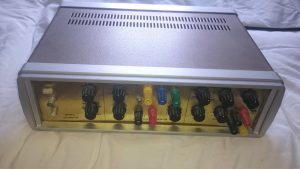
It’s built into a good case (thanks Roy from the long defunct Bradford Skillcentre) and uses wooden front and rear panels covered with self adhesive metal effect backing. It features a crystal oscillator for generating accurate signals, an audio signal generator with separate phases and a digital signal generator also known as a function generator. I’d even used a TXCO crystal to get the accuracy of the generated signals as good as they can get.
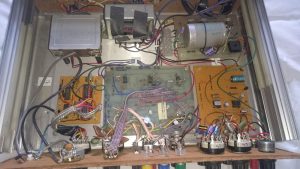 Inside view showing the two etched PCB’s I made for the audio signal generator and PSU board. The others were made on veroboard. At the rear left is the metal can containing the TXCO with the audio output board and speaker behind it. I can see on the board it was completed in 1992 which was when I I was in my final year at college. After that I started work and didn’t get the time to repair things like I used to and sadly this bit of equipment has been sat unused ever since. Shame really as I was quite proud of this at the time.
Inside view showing the two etched PCB’s I made for the audio signal generator and PSU board. The others were made on veroboard. At the rear left is the metal can containing the TXCO with the audio output board and speaker behind it. I can see on the board it was completed in 1992 which was when I I was in my final year at college. After that I started work and didn’t get the time to repair things like I used to and sadly this bit of equipment has been sat unused ever since. Shame really as I was quite proud of this at the time.
Other things
 Multi voltage lab power supply. Has since been modified to provide more current and different output voltages. It originally supplied 3-20V variable, 5V fixed, 15-0-15V fixed and -5V fixed. It was built to supply audio circuits (hence the 15-0-15 split rails) and 5V logic circuits. It has since been fitted with a voltmeter and outputs now are 3-20V @3A, 5V @ 1A, 12V @ 4A and 15V @ 500ma.
Multi voltage lab power supply. Has since been modified to provide more current and different output voltages. It originally supplied 3-20V variable, 5V fixed, 15-0-15V fixed and -5V fixed. It was built to supply audio circuits (hence the 15-0-15 split rails) and 5V logic circuits. It has since been fitted with a voltmeter and outputs now are 3-20V @3A, 5V @ 1A, 12V @ 4A and 15V @ 500ma.
There’s an 2.7 VAC supply used for supplying filament voltages to VFD’s which only came about because the transformer was salvaged from an old VCR.
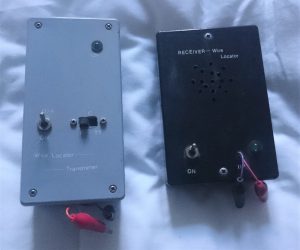 Wire locator – this actually came in handy when I worked for a telecoms company. I used it to identify pairs in a multi pair cable that had been cut in half. As my employer could not provide anything remotely like this the wire locator kit made my life much easier.
Wire locator – this actually came in handy when I worked for a telecoms company. I used it to identify pairs in a multi pair cable that had been cut in half. As my employer could not provide anything remotely like this the wire locator kit made my life much easier.
Cry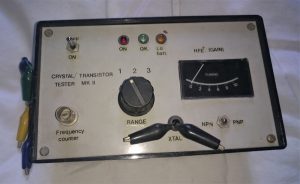 stal and transistor tester – yeah this wasn’t a waste of time and money. Built using parts salvaged from scrap audio equipment (I had to buy the case and knob) this was quite a handy device for checking the gain of transistors. It has since been rendered obsolete by my purchase of one of those cheap ebay transistor testers.
stal and transistor tester – yeah this wasn’t a waste of time and money. Built using parts salvaged from scrap audio equipment (I had to buy the case and knob) this was quite a handy device for checking the gain of transistors. It has since been rendered obsolete by my purchase of one of those cheap ebay transistor testers.
Other items I’ve made; TTL and CMOS logic probes, IR remote tester, live cable detector, IC tester which was used in conjunction with a BBC micro and finally a digital capacitor tester. Probably made some other things too I’ve forgot about.
